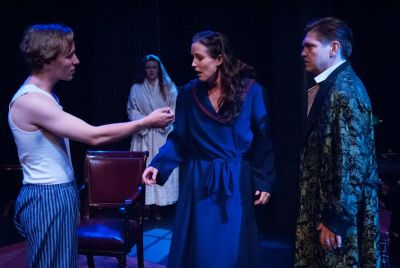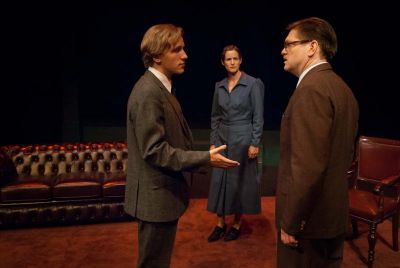Bracken Moor
Bracken Moor is an ingeniously multi-layered work – equal parts hard-hitting social commentary, heart-wrenching family drama and chilling gothic horror story.
Set against the backdrop of the 1937 Yorkshire mining crisis, the play opens with aristocratic mine-owner, Harold (Brant Eustice), deciding to lay off over 100 workers, despite the protestations of foreman, John (Angus Henderson).
Harold’s heart was hardened ten years prior by the premature death of his 12 year old son, Edgar (Sebastien Skubla), who accidentally fell down one of his mine shafts. This event prompted Pritchard’s wife, Elizabeth (Alicia Zorkovic), to descend into a state of clinical depression.
Hoping to help the Pritchards move forward from this experience, Edgar’s now grown up childhood-friend, Terence (Will Cox), decides to pay a visit to their country estate, along with his parents, Vanessa (Lyn Wilson) and Geoffrey (Michael Eustice).
Over the course of the evening, Terence undergoes a series of epileptic seizures and somnambulant trances, in which he seemingly speaks with the voice of the dead child. The Pritchards’ maid, Eileen (Heather McNab) and local doctor, Gibbons (David Roach), offer their support in solving this mystery and the most deeply held beliefs of all concerned are challenged in the process.

Although this is a period piece, much of what the early scenes have to say about the increasing mechanisation of industry and the importance of responsible human resource management are still relevant today. These themes are communicated to the audience, not in a pompous or preachy way, but with surprisingly subtle humour, as characters with radically different social perspectives engage in a bitingly witty war of words.
The play similarly avoids heavy-handed worthiness in exploring the many and varied forms that the grieving process takes, with much of the characters’ inner turmoil poignantly communicated in what they DON’T say, rather than through stereotypical histrionics.
The central mystery is twisted in the best possible way, building suspensefully to a series of shocking revelations that are logically consistent with the previously established facts of the narrative, but at the same time not easily predictable.
The intelligent script is imbued with added layers of meaning thanks to the depth of the cast’s performances.
A lesser actor might have pitched the character of Harold to the audience as a moustache twirling villain, but Brant Eustice instead portrays him as a product of his time, wringing some touching pathos out of the man’s inability to connect emotionally with those he cares about most.

Zorkovic and Cox give controlled and focused performances in parts that could’ve descended into pantomime hammery, their mania coming across as frighteningly realistic.
Wilson, McNab, Roach, Henderson and Michael Eustice all bring touching warmth and endearing affability to their supporting roles.
Skubala only has a few words as Edgar, but makes them count, his cameo is one of the most profoundly resonant scenes in this haunting play.
The general production design establishes just the right atmosphere of dread, with the lushly furnished drawing room of the Pritchards’ mansion framed by imposing wooden beams, suggestive of the entrance to a mine. Costumes and props were all period appropriate, as well as striking in their use of colour.
The only miscalculation of this production was having the actors perform their warm-up exercises live on stage prior to commencement of the performance, and again just before the beginning of the second act. Their goofy gesticulations detracted slightly from the dark ambience of the overall production.
Benjamin Orchard
Subscribe to our E-Newsletter, buy our latest print edition or find a Performing Arts book at Book Nook.

